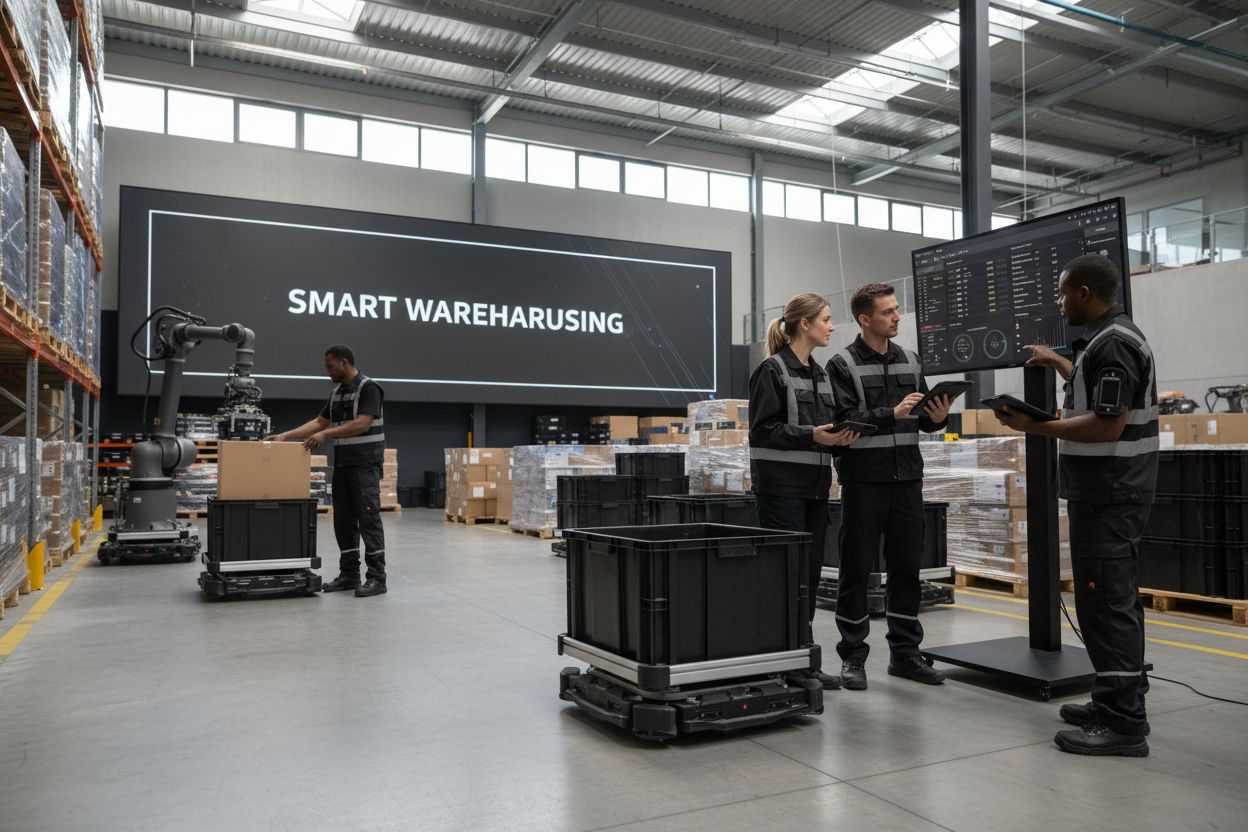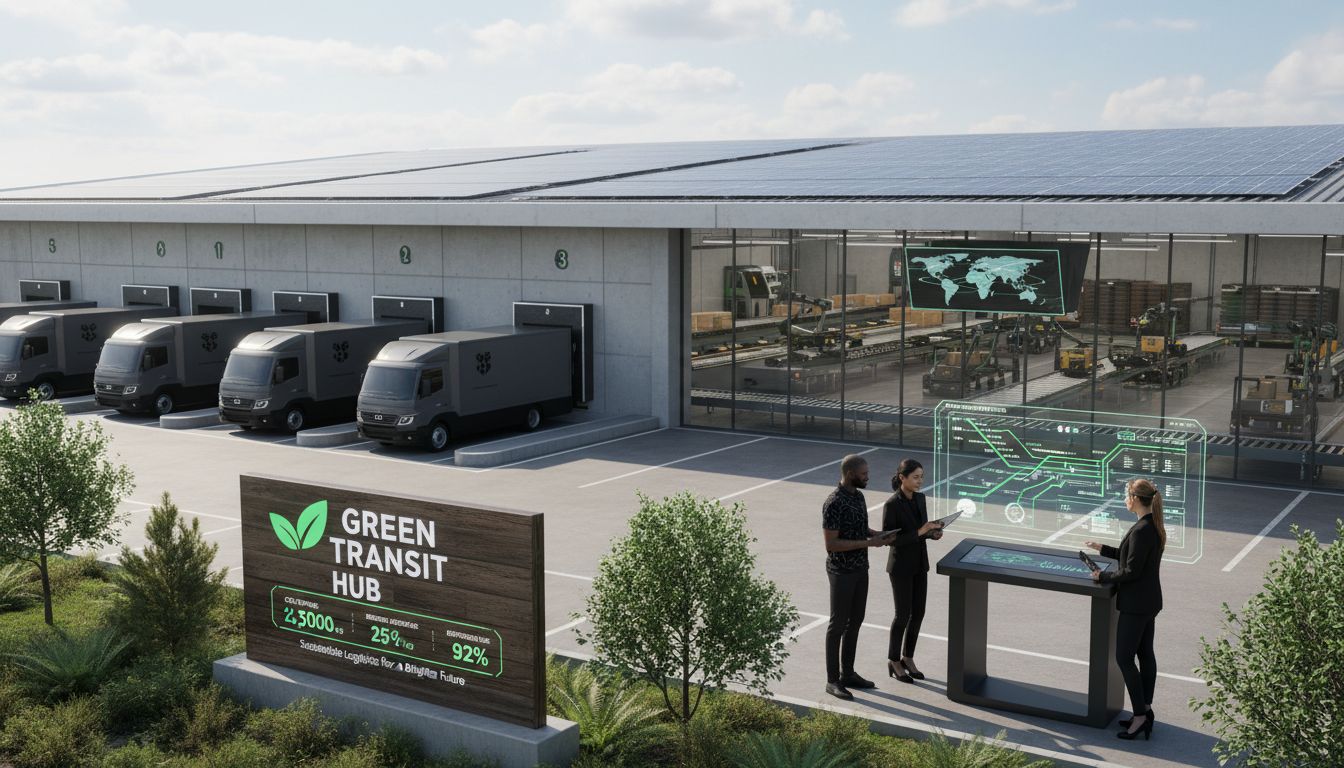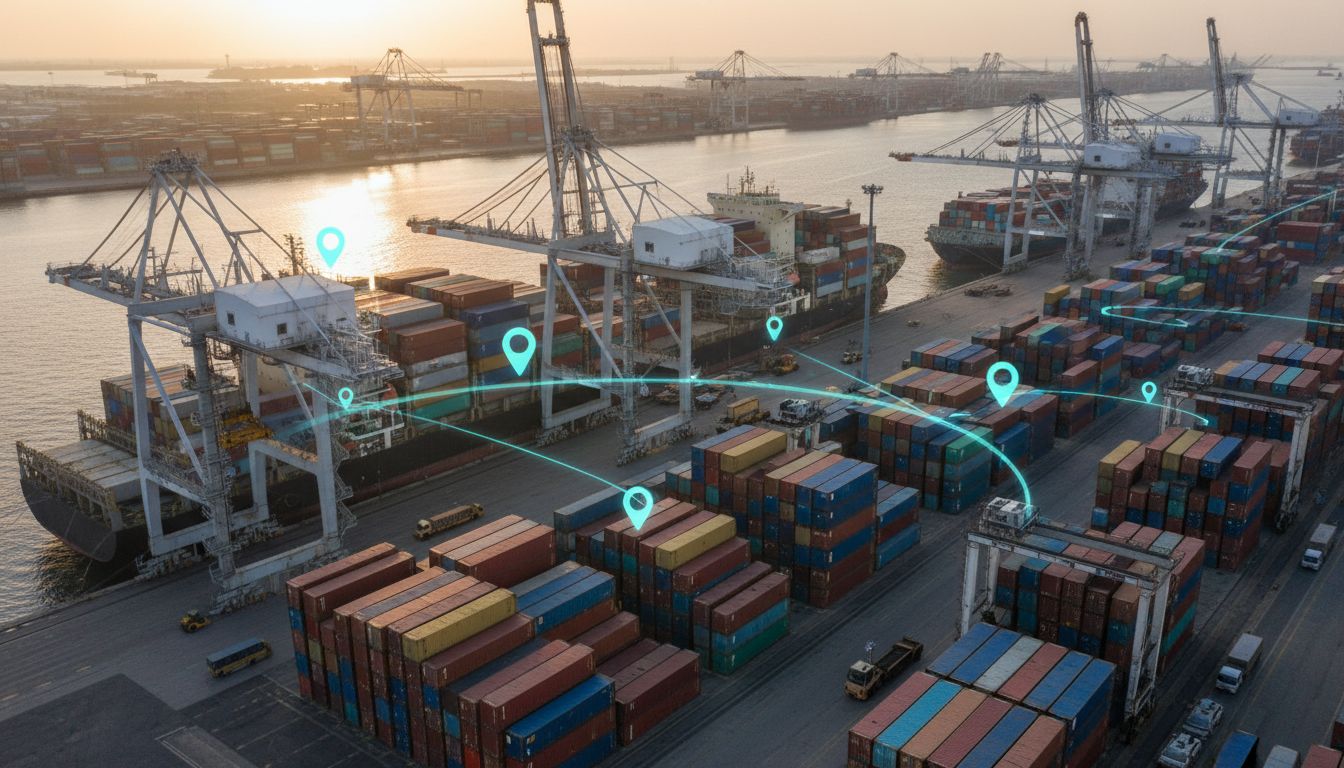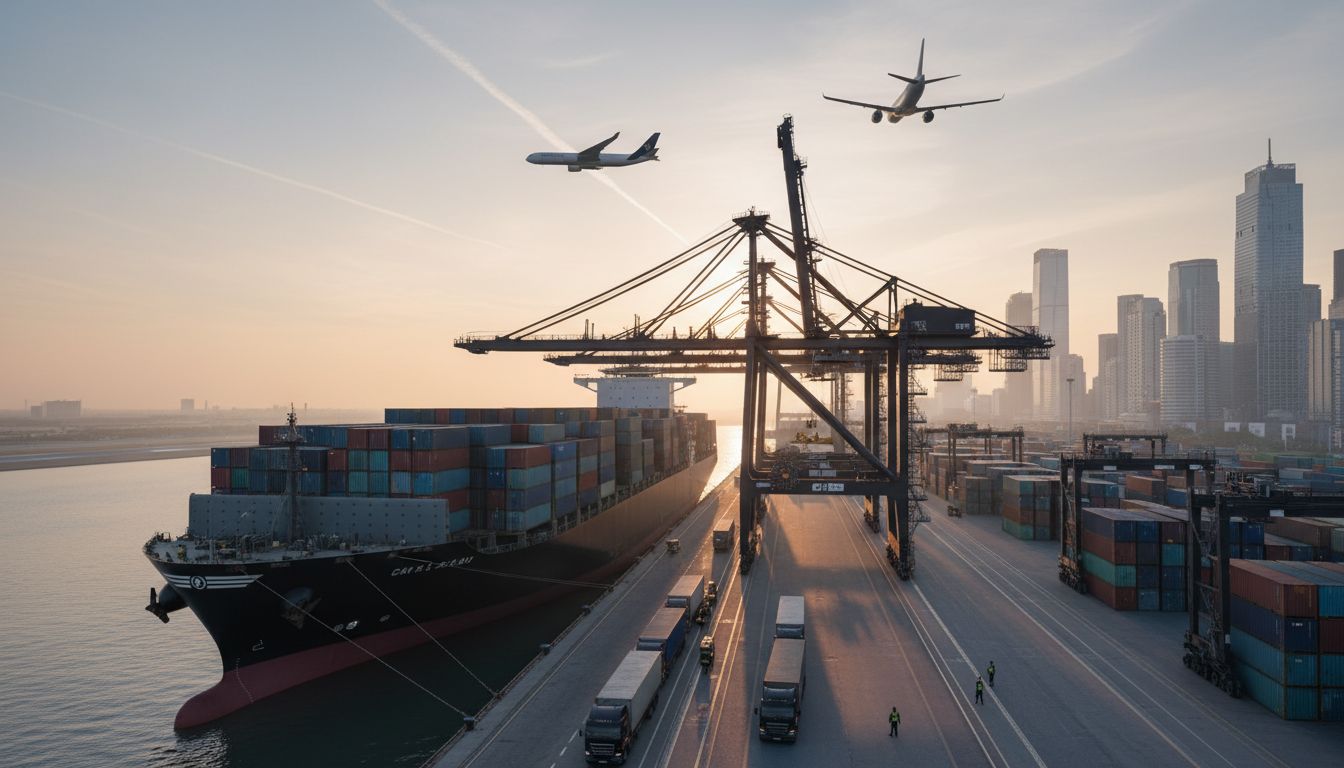Smart warehousing is changing everything about how goods move and get stored. Imagine warehouses that use robots, sensors, and software working together around the clock. That is not just hype because companies using smart warehousing see up to 60% improvement in operational efficiency. Most people think a warehouse is just a giant building filled with shelves and boxes. Now every inch of space is powered by real-time data and AI, flipping the old rules of logistics upside down.
Table of Contents
- Defining Smart Warehousing Solutions And Their Role
- The Importance Of Smart Warehousing In Today’s Economy
- Technologies Driving Smart Warehousing Solutions
- Key Components And Concepts Of Smart Warehousing
- Real-World Applications And Benefits Of Smart Warehousing
Quick Summary
| Takeaway | Explanation |
|---|---|
| Smart warehousing boosts efficiency by 30% | Implementing these solutions can lead to significant operational improvements, including reduced costs and faster order fulfillment. |
| Automated systems enhance inventory accuracy | Real-time tracking through automation minimizes errors and ensures better stock management in warehousing operations. |
| Smart warehousing drives economic sustainability | These solutions not only optimize resources but also contribute to environmentally responsible logistics practices. |
| Key technologies include IoT and AI | Utilizing IoT sensors and AI can transform traditional warehousing into intelligent systems, enhancing responsiveness and efficiency. |
| Industry-specific benefits vary widely | E-commerce, pharmaceuticals, and manufacturing can uniquely leverage smart warehousing technologies to solve distinct challenges in their sectors. |
Defining Smart Warehousing Solutions and Their Role
Smart warehousing solutions represent a technological evolution in logistics management, transforming traditional storage spaces into intelligent, data-driven environments that optimize operational efficiency. These advanced systems integrate cutting-edge technologies like artificial intelligence, Internet of Things (IoT) sensors, robotics, and sophisticated software platforms to revolutionize how businesses manage inventory, track assets, and streamline supply chain processes.
Core Components of Smart Warehousing
At the heart of smart warehousing solutions are several interconnected technological components that work seamlessly to enhance productivity and accuracy. These include:
- Automated Inventory Management Systems: Real-time tracking and monitoring of stock levels
- IoT Sensors: Providing continuous data about warehouse conditions and asset locations
- Robotic Process Automation: Enabling autonomous movement and handling of goods
- Advanced Analytics Platforms: Generating actionable insights from complex data streams
The comprehensive logistics guide offers deeper insights into these technological integrations.
Strategic Advantages of Smart Warehousing
Businesses implementing smart warehousing solutions gain significant competitive advantages. By leveraging real-time data and automated processes, companies can dramatically reduce operational costs, minimize human error, and accelerate order fulfillment times. These intelligent systems enable precise inventory management, predictive maintenance, and enhanced decision-making capabilities.
According to McKinsey & Company research, organizations adopting smart warehousing technologies can achieve up to 30% improvement in operational efficiency and 25% reduction in logistics expenses. These technological solutions are not merely incremental improvements but represent a fundamental reimagining of warehouse management in the digital age.
The Importance of Smart Warehousing in Today’s Economy
In an increasingly interconnected global marketplace, smart warehousing has emerged as a critical infrastructure component driving economic efficiency and competitive advantage. These technologically advanced systems are not merely storage facilities but strategic economic assets that enable businesses to respond rapidly to market dynamics, reduce operational costs, and enhance overall supply chain resilience.
Economic Transformation through Smart Technologies
Smart warehousing solutions represent a fundamental shift in how businesses approach inventory management and logistics. By integrating advanced technologies, companies can transform traditional warehousing from a cost center into a value-generating operational hub. Artificial intelligence in logistics plays a pivotal role in this economic transformation, enabling unprecedented levels of predictive analysis and strategic decision making.
Key economic impacts include:
- Reduced Operational Expenses: Minimizing labor costs through automation
- Enhanced Inventory Precision: Eliminating waste and optimizing stock management
- Faster Market Response: Enabling quicker product distribution and customer fulfillment
- Global Competitiveness: Creating more agile and adaptable supply chain ecosystems
Strategic Economic Benefits
Businesses implementing smart warehousing solutions gain substantial economic advantages. These intelligent systems enable companies to process orders faster, reduce inventory holding costs, and provide more accurate tracking and forecasting. According to Gartner Research, organizations leveraging advanced warehousing technologies can achieve up to 40% improvement in overall supply chain efficiency.
Moreover, smart warehousing contributes significantly to economic sustainability by reducing waste, optimizing resource allocation, and creating more environmentally responsible logistics infrastructure. The economic implications extend beyond individual companies, potentially reshaping entire industrial ecosystems and global trade networks.
Technologies Driving Smart Warehousing Solutions
The technological landscape of smart warehousing is rapidly evolving, powered by sophisticated innovations that transform traditional logistics operations into intelligent, responsive systems. These cutting-edge technologies work synergistically to create unprecedented levels of efficiency, accuracy, and operational intelligence in warehouse management.
The table below summarizes the core technologies driving smart warehousing, organizing each foundational component and its main function within smart logistics environments.
| Technology | Primary Function |
|---|---|
| Internet of Things (IoT) Sensors | Real-time monitoring and data collection |
| Artificial Intelligence (AI) | Advanced predictive analysis and strategic decision-making |
| Machine Learning Platforms | Continuous improvement of operational insights and efficiency |
| Cloud Computing Infrastructure | Seamless data integration and scalability |
| Robotics | Autonomous movement and handling of goods |
Core Technological Foundations
At the center of smart warehousing technologies are several interconnected systems that enable real-time tracking, automated processes, and predictive analytics. Key technological drivers include:
- Internet of Things (IoT) Sensors: Enabling continuous monitoring and data collection
- Artificial Intelligence Algorithms: Providing advanced predictive and decision-making capabilities
- Machine Learning Platforms: Continuously improving operational insights and efficiency
- Cloud Computing Infrastructure: Supporting seamless data integration and scalability
The sustainability insights in logistics highlight how these technologies contribute to more environmentally responsible supply chain management.
Advanced Technological Integration
Modern smart warehousing solutions leverage complex technological integrations that go beyond simple automation. Robotics, autonomous guided vehicles, and advanced vision recognition systems work in concert to create dynamic, self-optimizing warehouse environments. According to Deloitte Research, companies implementing these advanced technologies can achieve up to 60% improvement in operational efficiency and significant reductions in human error.
These technological solutions represent more than incremental improvements they constitute a fundamental reimagining of warehouse management, transforming logistics from a cost center into a strategic competitive advantage.
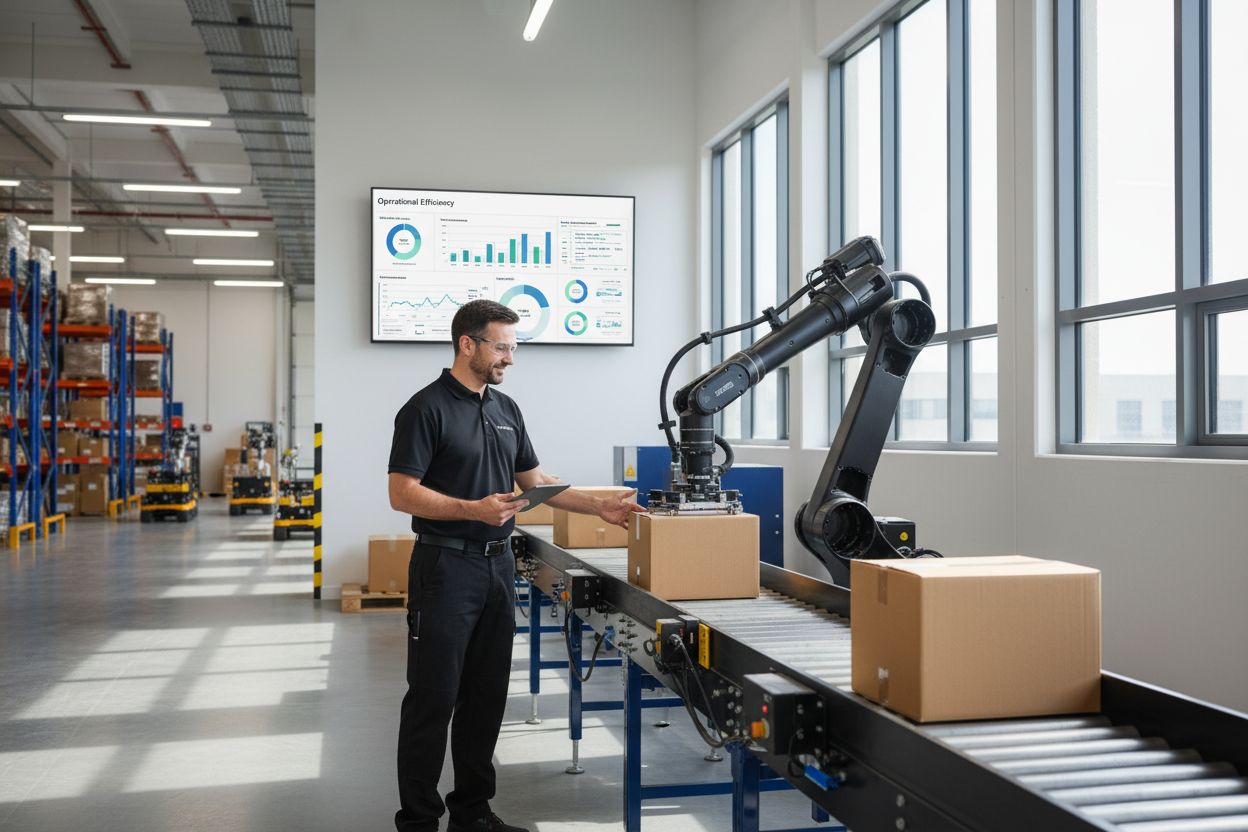
Key Components and Concepts of Smart Warehousing
Smart warehousing represents a sophisticated ecosystem of interconnected technological components designed to optimize logistics operations. These systems integrate multiple advanced technologies and strategic frameworks to transform traditional warehouse management into intelligent, responsive, and highly efficient operational environments.
Fundamental Architectural Components
The infrastructure of smart warehousing is built upon several critical technological and strategic foundations that work collaboratively to enhance operational performance. These core components include:
- Sensor Networks: Providing real-time tracking and environmental monitoring
- Automated Inventory Management Systems: Enabling precise stock control and forecasting
- Integrated Software Platforms: Facilitating seamless data communication and analysis
- Advanced Robotics: Supporting autonomous material handling and processing
Our digital freight forwarding insights provide additional context on how these technological components interconnect within modern logistics frameworks.
Strategic Operational Concepts
Beyond technological infrastructure, smart warehousing introduces several transformative operational concepts that redefine traditional logistics paradigms. These strategic approaches emphasize adaptability, predictive intelligence, and continuous optimization. According to Gartner’s Logistics Technology Report, organizations implementing comprehensive smart warehousing strategies can achieve up to 45% improvement in operational responsiveness and resource utilization.
The conceptual framework of smart warehousing extends far beyond simple automation, representing a holistic approach to logistics management that integrates technological innovation, data-driven decision making, and strategic organizational adaptation.
Real-World Applications and Benefits of Smart Warehousing
Smart warehousing has transitioned from theoretical concept to practical reality, demonstrating transformative capabilities across multiple industries. These advanced technological solutions are delivering tangible benefits that fundamentally reshape logistics operations, inventory management, and supply chain efficiency.
Industry-Specific Implementation Strategies
Different sectors are leveraging smart warehousing solutions to address unique operational challenges. Manufacturing, e-commerce, pharmaceutical, and automotive industries are pioneering innovative applications that optimize resource allocation, enhance product tracking, and minimize operational risks. These targeted implementations showcase the adaptability and versatility of smart warehousing technologies.
This table provides a side-by-side overview of how smart warehousing technologies are applied across different industries, capturing sector-specific benefits and implementation strategies.
| Industry | Key Application | Primary Benefit |
|---|---|---|
| E-commerce | Rapid order processing and inventory synchronization | Faster order fulfillment, accuracy |
| Pharmaceutical | Temperature monitoring and regulatory compliance | Product safety, compliance |
| Automotive | Just-in-time parts tracking | Streamlined manufacturing, reduced delay |
| Agriculture | Management of perishable inventory | Reduced waste, improved traceability |
Key industry applications include:
- E-commerce: Enabling rapid order processing and real-time inventory synchronization
- Pharmaceutical: Ensuring precise temperature monitoring and regulatory compliance
- Automotive: Supporting just-in-time manufacturing with advanced parts tracking
- Agriculture: Managing complex supply chains with perishable inventory management
Our understanding of digital freight forwarding provides additional context on technological integration across different sectors.
Quantifiable Operational Benefits
The economic and operational advantages of smart warehousing extend far beyond incremental improvements. According to McKinsey & Company research, organizations implementing comprehensive smart warehousing strategies can achieve significant performance enhancements:
- 25-40% reduction in operational expenses
- Up to 50% improvement in order fulfillment speed
- Near-zero inventory discrepancy rates
- Dramatic decrease in human error and workplace accidents
These technological solutions represent a strategic investment that delivers measurable returns across multiple operational dimensions, positioning businesses for enhanced competitiveness in increasingly complex global markets.
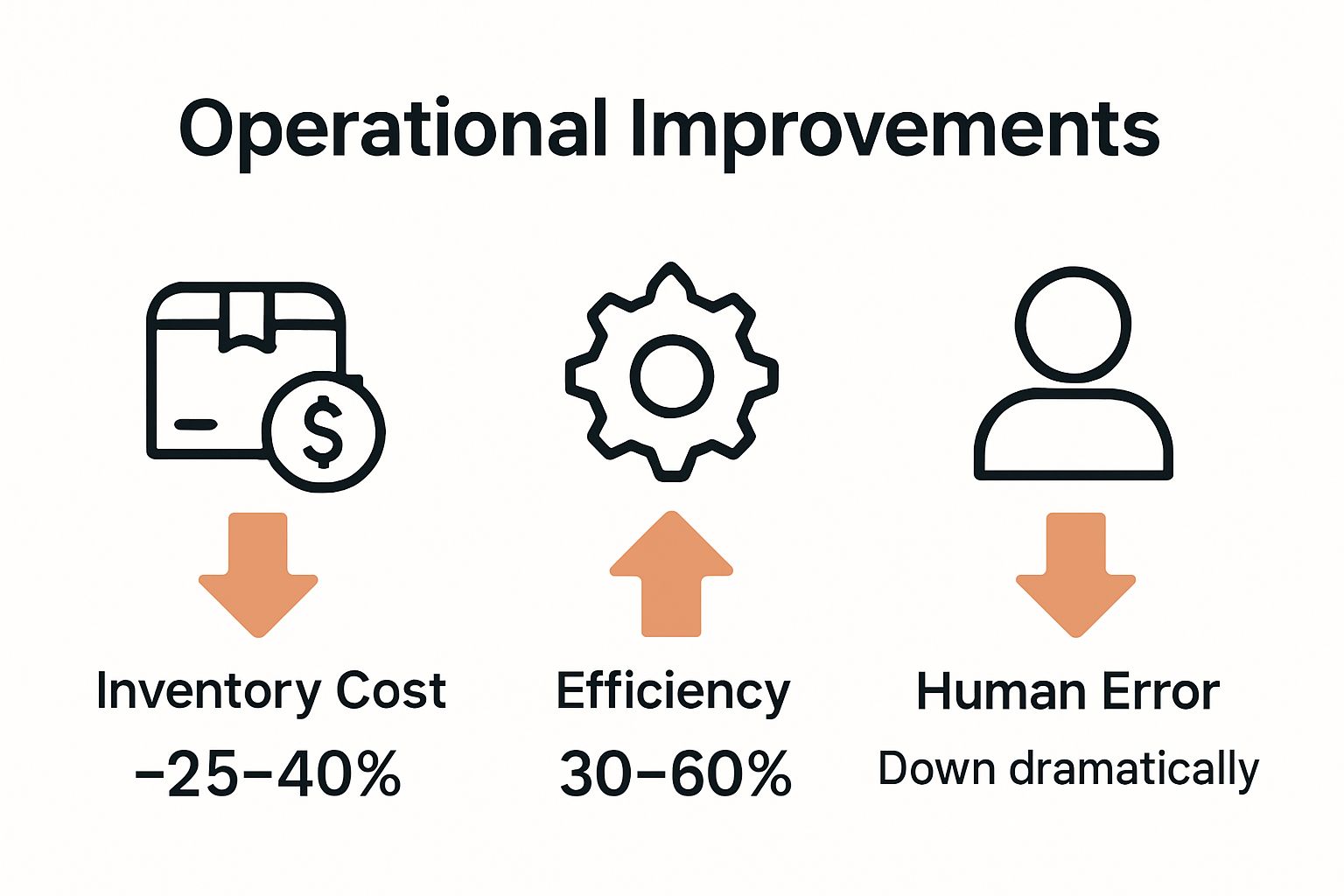
Achieve True Trade Success With Smart Warehousing and Worldwide Express
Smart warehousing is more than just technology—it is your pathway to efficient, resilient, and future-ready international trade. As the article highlights, companies today face challenges like inventory uncertainty, slow fulfillment, and the need for fast market response. These pain points can create costly delays and lost opportunities. Real-time tracking, advanced analytics, and integrated systems are not just industry buzzwords; they are now essential tools for staying competitive. If you feel your current supply chain is holding you back, imagine what your business could do with true operational transparency and reliability.

Transform your warehouse operations and unlock new possibilities for your business. Worldwide Express, Inc. offers specialized logistics solutions that put the latest smart warehousing strategies within your reach. Visit Worldwide Express to start a tailored approach to streamlining your storage, shipping, and cross-border logistics. Don’t let slow processes or outdated methods cost you another sale—explore how our proven expertise and global reach can connect your products to the world, today.
Frequently Asked Questions
What are smart warehousing solutions?
Smart warehousing solutions are advanced technological systems that transform traditional storage environments into intelligent, data-driven operations. They utilize technologies like AI, IoT, and robotics to optimize inventory management, asset tracking, and supply chain processes.
How do smart warehousing solutions improve operational efficiency?
These solutions enhance operational efficiency by automating inventory management, providing real-time tracking through IoT sensors, and utilizing advanced analytics to generate actionable insights, ultimately leading to reduced costs and accelerated order fulfillment times.
What technologies are integral to smart warehousing?
Key technologies include IoT sensors for monitoring, AI algorithms for predictive decision-making, machine learning platforms for operational insights, and cloud computing for seamless data integration and scalability.
How does smart warehousing benefit different industries?
Smart warehousing offers tailored applications for various industries like e-commerce, pharmaceuticals, and automotive, allowing for rapid order processing, precise regulatory compliance, and improved supply chain management tailored to sector-specific needs.
Recommended
- Understanding Trade Finance Solutions: A Clear Guide – Worldwide Express, Inc.
- Understanding Sustainability in Logistics: Key Insights – Worldwide Express, Inc.
- 8 Packing List Essentials for International Trade Success – Worldwide Express, Inc.
- Understanding Artificial Intelligence in Logistics – Worldwide Express, Inc.
- Navigating the New Normal: Digital Solutions for Supply Chain Resilience
- In-Store Operations: Challenges and Solutions – Omnichannel payments at the Point Of Sale | Sensepass

